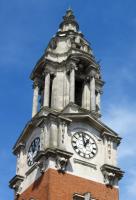
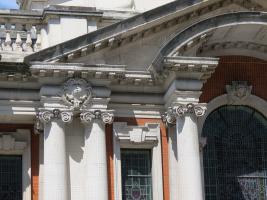
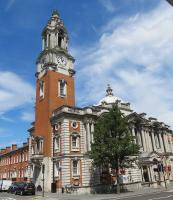
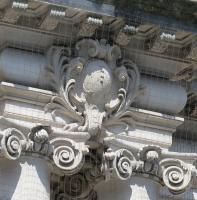
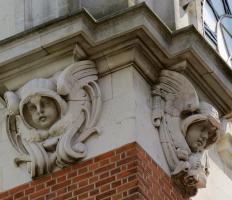
In Woolwich, the Town Hall is not on one of the main shopping streets but has its principal frontage onto Wellington Street, with a long side facing onto Market Street, and associated municipal buildings on the rear (Bathway) and other side (Polytechnic Street). The dominant feature is the clock tower, Edwardian Classical Baroque, plain red brickwork on the shaft and white stone above, with upper tiers of diminishing size and various pillars and ornaments in archetypical Edwardian fashion.
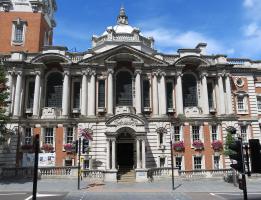 Woolwich Town Hall, frontage to Wellington Street.
Woolwich Town Hall, frontage to Wellington Street.
The main frontage to Wellington Street cannot be seen from enough distance because the width of the street is not large enough: the building should better have faced onto some square. To the right is an ill-placed modern block. Thus the best view to appreciate the edifice is from slightly along the street to the left, where we see the tower, the frontage, most obliquely, and a dome above it, and the long side. To that side is mostly red brick, and the body of the tower likewise, so we have a Queen Anneish style to the whole, but the main frontage is mostly stone, so Edwardian Baroque. The main impression from across the road is of the upper storey or ‘piano nobile’ with its numerous Ionic pillars between tall arched and square-headed windows – if there were not the pillars in between we could call them Venetian windows; below this we have the central portico, with smaller coupled pillars on each side, and to the sides, a raised ground floor and a sunken semi-basement floor.
Decorative elements, sculptural details by H. H. Martyn.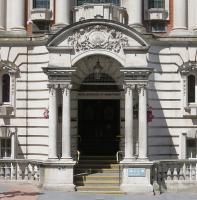
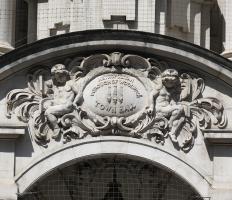
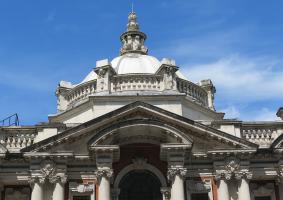
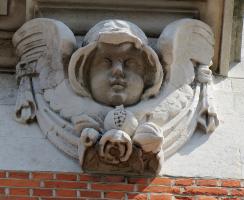
The sculptural decoration to the Wellington Street includes the arched pediment above the entrance, which has two naked cherubs, muscular of build rather than the normal fleshy plumpness (if you like cherubs, see this page), on either side of a central oval indicating that this is the Town Hall. Higher up is a keystone cherub head, but the rest of the sculpture on this elevation is very minor: the decorations on the pillars, cartouches above with crossed branches, repeating decoration on the entablature, and so forth. The top of the tower is better, with the surrounds of the clock on each side supported by a pair of winged cherub heads, characteristically turn of the Century in design, carved hanging cloths above, and flowers etc higher up, with four more winged cherub heads at the summit beneath a crown. All rather Wrenish.
More interesting sculptural work is on the Market Street side. At the base of the tower, the first floor window protrudes on a balcony – the Mayor’s own – and is supported on an elaborate corbel (supporting bracket) with the arms of Woolwich on a cartouche, with male cherubs as supporters on each side, excellent scrolling, and at the top, crossed weaponry. Nicely made, and this, and the rest of the external sculpture, demonstrate the work of the firm of H.H. Martyn of Cheltenham, an important and prolific maker of architectural sculpture.
Proceeding along Market Street, we come to a fine group of three arched doorways with side pillars, with an interesting assemblage of architectural sculpture around the tops, forming a continuous grouping across the whole. We see four groupings of trophies, with crossed flags and weapons of various sorts, wreaths, weapons, and olive branches, each one with different elements; the double spandrels (between pairs of arches) are larger and more elaborate; the smaller, triangular spandrels at the end arches are smaller and simpler. Each trophy has above it a carved head. The two central heads are idealised female ones, with long, snakey hair and wings to the sides. The outer head to the the left, a bearded man wearing a hood made of a lionskin; a figure of law and order (see the page on lion heads for interpretations), above a drum, and other accoutrements linked by oakleaves. To the right is a discoloured head, older, male I think, wearing a crown of olive leaves and with a helmet underneath, and more olive branches. Again, all by H.H. Martyn.
Woolwich Town Hall was put up from 1903-1906, the architect being Alfred Brumwell Thomas, not a familiar figure today, but important as the architect of two buildings of gargantuan size: Belfast City Hall and Stockport Town Hall, these buildings being more or less contemporary with Woolwich Town Hall.
I have not been inside the building, which contains original interiors with domed ceilings, and wooden and plaster carvings, work by the Bromsgrove Guild, and a marble statue of Queen Victoria by F.W. Pomeroy: an illustration of the original painted decoration is below.
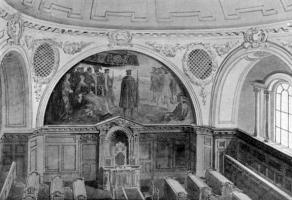 Interior mural by E. J. Lambert.
Interior mural by E. J. Lambert.
A wander can be made around the block and adjacent streets, to see other things contemporary with the 1906 Town Hall and in similar though plainer Queen Anne Baroque style, including the Library, public baths and courts, with various decorative sculptural elements, most notably architectural trophies of crossed weapons. The previous Town Hall, a small, rather plain Classical building of 1842, also survives.
Most British town halls of the grander type were put up in Victorian and Edwardian times. Some examples are noted on this website, including in South London, Deptford Town Hall and Shoreditch Town Hall, and among grander ones elsewhere, Birmingham Council House (see this page), Bradford City Hall, Colchester Town Hall (see this page), Leeds Town Hall, St George's Hall in Liverpool (see this page), Manchester Town Hall, Northampton Guildhall and Portsmouth Guildhall.
This page was originally part of a 'sculpture of the month' series, for December 2015. Although the older pages in that series have been absorbed within the site, if you would wish to follow the original monthly series, then jump to the next month (Xmas turn of the year 2015-16) or the previous month (Nov. 2015). To continue, go to the bottom of each page where a paragraph like this one allows you to continue to follow the monthly links.
London sculpture // Architects
Visits to this page from 1 Dec 2015: 5,956